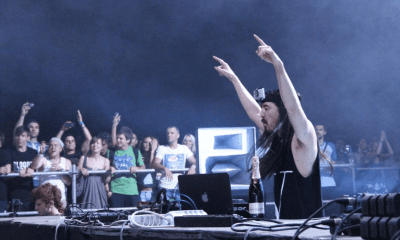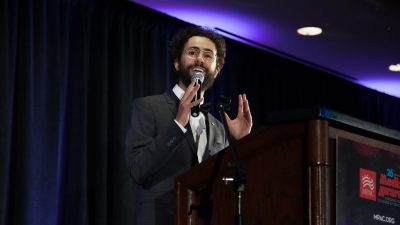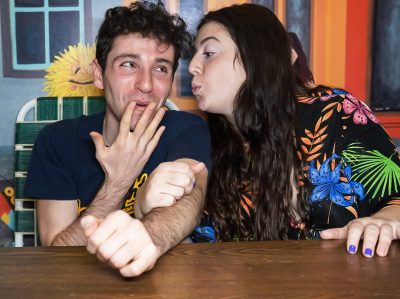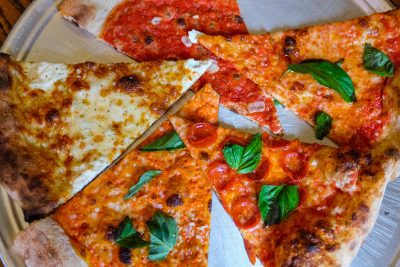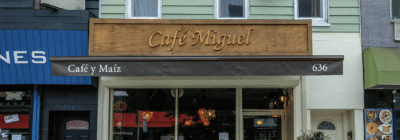Courtesy Charlotte Chauvin
Pandemics make strange bedfellows, too
How Covid nudged unemployed performance artists into the arms of a museum on the brink
As performance venues closed, galleries shut their doors, and expendable income dried up last year, Brooklyn artists found themselves, in the words of actor and magician Daniel Taylor, “sinking deeper and deeper into poverty.”
However, if there’s one thing about artists—be they furniture designers, or sculptors or poets—it’s that creatives are … creative.
For Brooklyn artists Charlotte and Emily Chauvin, Clinton Hill-based immersive actors, unexpected constraint has forced a little unexpected creativity.
While late summer found the sisters sharing a bedroom to reduce their rent, they also found themselves with an unfamiliar surplus: time. A cancelled festival season left the two with empty performance calendars. Emily had taken a job in an apple orchard for the warmer months and Charlotte waited tables. But because Emily is immunocompromised Charlotte had to let go of the work as the weather got colder and diners moved inside.
But it was an additional Covid casualty that gave the twins another outlet for their creativity: The City Reliquary was on the edge of extinction.
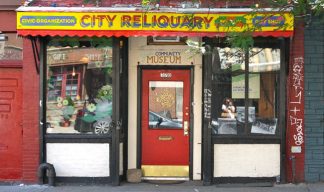
City Reliquary
From tchotchkes to theater
Emily and Charlotte volunteer at the tiny but beloved Williamsburg museum on Metropolitan Ave. The City Reliquary’s three rooms and backyard are stuffed with New York City artifacts. Here you might come across disco skates from the heyday of Brooklyn roller-derby next to archaic subway tokens, or terra cotta fragments of landmark buildings.
Over the course of the pandemic foot traffic slowed to a trickle, though, and without this source of revenue, The City Reliquary was being forced to shut its doors for good. Short on money but long on time, Charlotte quickly produced what she called an “immersive Halloween variety show” that took place in the museum’s patio. With masks, hand sanitizer, and six feet of fresh air between attendees, she brought together poets, drag queens, clown acts, musicians and, most importantly, an audience.
“It was just so merry,” says Emily.
But best of all, it worked. “There was a date that we had to get 300 memberships by, and at midnight we got as many as we needed,” says Charlotte.
Amy Palen, who performed original poetry as well as Poe renditions at the event, says she “literally couldn’t imagine a better evening.”
Glass cases of emotion
Since that first show, the Chauvins have produced a holiday bazaar and have more immersive storytelling events in the works at the museum for spring.
“Anyone who has something worth showing, especially if it’s even tangentially related to New York history, I would like to offer our space for them to do it,” says Jacob Ford, the museum’s director of outreach and programming. During the pandemic, The City Reliquary has also hosted performances in collaboration with live-music startup Groupmuse and became the home of the Last Chance Dancers, a monthly outdoor burlesque series. (If that sounds chilly, that’s because it is. Dancers say they got better tips in the cold, though.)
After performing at the Chauvins’ show, burlesque dancer Venatrix teamed up with Maggie McMuffin to co-produce their shows, during which the dancers perform to the entirety of a vinyl record. “The space lent itself to doing socially distanced performance,” Venatrix says. In the shows she produced, performers appeared in the museum’s exhibit display cases. “They were in glass cases,” she says, “so it was literally no-contact.”
Many performers have felt limited by a lack of venues or the move to Zoom. “The Reliquary, instead of limiting us, has made us feel freer,” says Venatrix. “We smashed a TV with baseball bats for one of our shows. There’s almost no venue where we could have done that safely.”
Venatrix emphasized how much she sees this performance series as an opportunity to transform Covid restrictions into springboards for new work. “Every time we’re there we feel like we get to do something we never would have gotten to do without the pandemic.”
Indeed, it was the existential threat Covid posed to the Reliquary that inspired this new collaboration between museum and performing arts. Charlotte says that the museum’s staff was thrilled to work with performers “to make the Reliquary come alive again for the community of Williamsburg.”
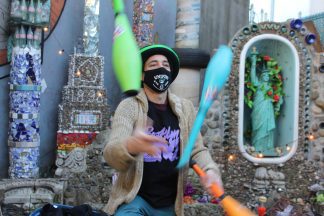

Holiday Bazaar, courtesy Charlotte Chauvin
A pandemic plus-side
“I had been wanting to turn the museum into a bit more of an event space,” says Ford. “It’s ironically Covid that kicked that into high-gear.” Squeezed by the financial pressures of the pandemic, the museum transformed its revenue plan into a Patreon-inspired monthly membership model. “We wanted to turn our events program into something worth supporting through memberships,” Ford says.
The collaboration is still evolving. Both the museum and the performers are thinking creatively about how to thrive throughout the winter. “Right now we’re considering doing even a 20-minute site-specific immersive play there, because it’s so cold,” says Emily.
And Ford is optimistic that many of these new offerings at the museum will last well beyond the threat of the coronavirus. “I would love if the Reliquary could be seen as a collective space for performance to happen,” he says, “ just constantly overflowing with interesting and weird things happening.”
You might also like 

















